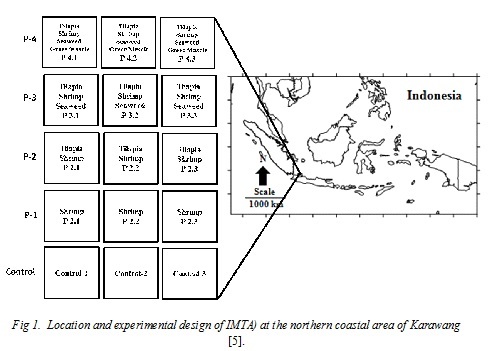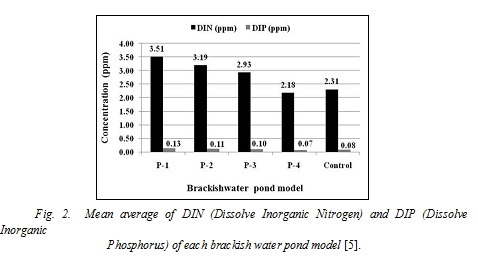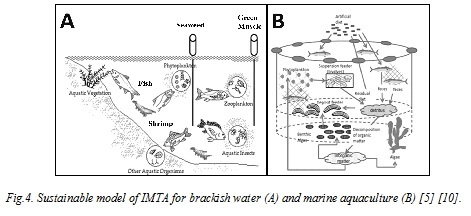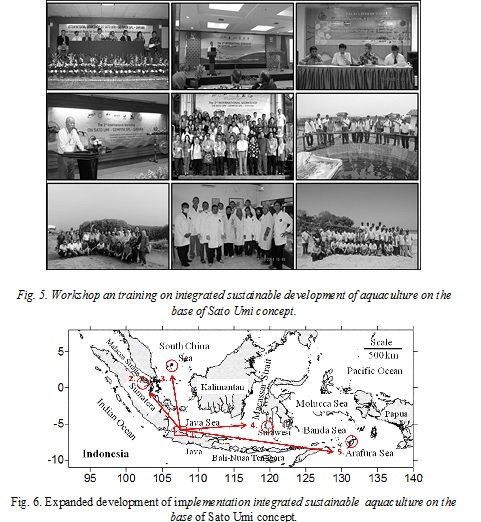BISAC NAT010000 Ecology
BISAC NAT045050 Ecosystems & Habitats / Coastal Regions & Shorelines
BISAC NAT025000 Ecosystems & Habitats / Oceans & Seas
BISAC NAT045030 Ecosystems & Habitats / Polar Regions
BISAC SCI081000 Earth Sciences / Hydrology
BISAC SCI092000 Global Warming & Climate Change
BISAC SCI020000 Life Sciences / Ecology
BISAC SCI039000 Life Sciences / Marine Biology
BISAC SOC053000 Regional Studies
BISAC TEC060000 Marine & Naval
The development of sustainable model of aquaculture by applying Sato Umi concept within coastal area of Indonesia has expanded from the center of first experiment in the northern coastal area of west Java to central Java (western Indonesia) and Bantaeng in the South Sulawesi of central Indonesia. The similar program has also been proposed for Maluku Province in the eastern part of Indonesia. In the next 5 years, Indonesia is developing the Techno Parks Program in some areas, in which aquaculture and fisheries activities development on the base of Sato Umi concept in the coastal area are involves in this program. The development of Techno Parks are directed as a center application of technology to stimulate the economy in the regency, and a place of training, apprenticeship, technology dissemination center, and center business advocacy for the public. Hopely, Sato Umi concept that has a similar spirit with Techno Park can be applied to support the implementation of Techno Park program in Indonesia
sustainable aquaculture, sato umi, productivity, coastal area, Techno Park, Indonesia
I. Introduction
FAO estimates that the global needs of the fish and fish processed products in 2015 increased to 183 million tons. This means there is a significant increase when compared with the number of requests in 1999/2000, reaching 133 million tons. This figure shows that the level of dependence of the global community in fishery products is so high that in line with the increase of population, each year the demand for fishery products increased by 3.1% [1]. The government effort to fulfill of food needs of Indonesia's population that is expected to reach more than 240 million people in the year 2015-2019, is not easy to make it happen. Food derived from agriculture is not only food as a source of carbohydrates, but also as a source of protein that is required for the fulfillment of adequate nutrition for health and growth. Although protein consumption society can still be obtained from a source of grains and cereals, such as soybeans and corn, but the nutritional value, especially essential amino acids, proteins derived from animals not replaced. When this pattern desired food and energy sources of animal protein in Indonesia reached of 7% is still far from the ideal of 12%. The pattern of animal food from meat, eggs, milk and fish totaled 95.9 g/capita/year is still far from the expectations of 150 g/capita/year [2].
The development of animal protein based food like fish in Indonesia has not run optimally. The challenge of increasing aquaculture production for food security in the future is not getting lighter. Global climate change has affected the cultivation system with projected production increasingly unpredictable. Diminishing cropland due to the rapid industrial development and settlement, while land available is not utilized optimally. Aquaculture development forward confronted with the changing strategic environment both domestically and internationally dynamic that demands aquaculture products capable competitive in the global market. Meanwhile, the potential utilization of marine aquaculture area of Indonesia in 2013 reached of 2.7 percent of the 12.1 million hectares. For that we need improved utilization through diversification of commodities such as grouper, white snapper, seaweed, sea cucumbers and oyster, as well as the development of technology that leads to efficiency, productivity and sustainability as Integrated Multi Trophic Aquaculture that is developed on the base Sato Umi concept. Through the development of marine aquaculture technology innovations that are environmentally friendly, productive and sustainable as developed in the concept Sato Umi, the expected productivity of marine aquaculture may significantly increase both at the local, regional and even national.
II. Development of Intengrated Multi trophic Aquaculture (IMTA) and Sato Umi
The Integrated Multi Trophic Aquaculture (IMTA) Technology Based on Sato Umi concept and a sustainable fish farming technology is environmentally friendly (green technology) because it is Zero Waste or waste-free. With this technology, the productivity of coastal brackishwater and marine aquaculture can be enhanced through the business development of aquaculture in an integrated and intensive of various commodities finned fish, seaweed, sea cucumbers and oyster reared in an area with water quality maintenance. In this system, organic waste of food remains and fish feces will be used by oyster and sea cucumber for growth, while the seaweed will utilize inorganic nutrients for growth to create a balance of the ecosystem [3] [4]. Thus the productivity of cultivated integrated commodities can grow and develop in an optimal and efficient utilization of marine resources available. Integrated sustainable aquaculture technology on the base of Sato Umi, if successfully applied in a whole marginal area of Indonesia, the income of the community, the region and the country's economy as a whole will increase.
The development and popularization of the integrated sustainable aquaculture technology on the base of Sato Umi by using high economics value varieties specimens of aquaculture such as tilapia, milkfish, shrimp, snapper and grouper with seaweed, sea cucumbers and oyster in the area of coastal marine aquaculture is a strategic activity to be promoted. This activity is very helpful in order to support the improvement of national aquaculture production in a sustainable manner, the expansion of employment and increase state revenues. The Integrated Multi Trophic Aquaculture (IMTA) technology that is developed on the based of bio recycle system and Sato Umi concept is a model that is suitable to be developed to support the revitalization program for increasing aquaculture export product (PROPEKAN), public consumption (PROKSIMAS) and protection of fishery resources (PROLINDA).
An experiment to clarify the sustainable model of the Integrated Multi Trophic Aquaculture (IMTA) model has been conducted in the marginal brackish water pond area at the northern coastal area of Karawang, West Java, Indonesia as shown in Fig.1 [5]. This experiment is a part of the SATOUMI concept application to sustain and improve aquaculture productivity with environmental stability, high biodiversity and involving community intervention to create the aquaculture sustainable model [6]. The experiment used four (4) aquaculture models using 500 m2 pond of each with three (3) replications (Fig.1). The model-1 (P-1) contains seed of black tiger shrimp fry with density 5 shrimp/m2. Model-2 (P-2) contains seed of tilapia and black tiger shrimp fry with density of each, 5 fish and shrimp/m2. Model-3 (P-3) contains the same density with P-2 of tilapia and blacktiger shrimp, with additional algae/seaweed (Gracillaria, sp) in the long line system with density of 0.1 kg/m2 per point. Model-4 (P-4) contains the same composition and density with P-3 of tilapia, black tiger shrimp and algae/seaweed (Gracillaria, sp) with additional benthic organism of oyster green mussel (Pernapiridis, sp) in the longline system with density 100 g per point, and as a control we used pond without organism.

Based on the analysis and evaluation of water quality (temperature, salinity, pH, DO, turbidity, TSS, BOD5, DIN and DIP) of 4 models brackishwater pond and control as shown in Table 1, indicated that water quality for all models is normal to support the aquaculture organism life. Though the pond in the land is located a few hundred meters away from the coastline and there is a channel between the pond and the sea, but no significant water exchange occur between the pond and the sea because the water from the channel was filled manually to the pond using a pump. The interesting situation is seen on the model of P-4 where temperature and DO are relatively high, while salinity and pH are low. High DO concentration of P-4 model exposed the enrichment of DO as response to the availability of algae/seaweed (Gracillaria, sp) that produced DO through high intensity of photosynthesis and it is stimulated by high temperature. The almost similar situation was seen on P-3 in which the DO concentration was higher than that in P-1 and P-2. High turbidity in P-4 model seems due to high chlorophyll-a because TSS is low. From this situation it can be concluded that the presence of seaweed in P-4 and P-3 model has improved the water quality.
Table 1. Water qualities of each brackish water pond model [5].

Moreover, based on the data shown in Fig.2, the DIN concentration of P-4 is the lowest even compared to the control. This situation indicates that P-4 containing green muscle as the organic consumer organism and seeweed as an inorganic consumer has contributed on the reduction of DIN concentration through the biorecycle system. In this system, organic material derived from residual feed, fish waste and other sources will be used for the growth of seaweed and green muscle. As the result, water quality and ecosystem of P-4 to be more stable compare to the other models. Statistical analysis shown in Table 3, strengthened the situation that P-4 model is significantly different with the other models on the DIN concentration, but no significant with control. It means that the biorecycle system in the integrated multi trophic aquaculture model worked well in the reduction of DIN concentration of P-4 model. The similar situation was seen on the DO concentration in which P-4 model is significantly different with the other models and control. High DO concentration of P-4 model is stimulated by availability of seaweed and high temperature that contributed on the intense of photosynthesis. High DO concentration was also shown by P-3 model compared with P-1, P-2 and control. The availability of seaweed in P-3 model has also contributed on the enrichment of DO concentration. The different situation was seen on the DIP that is no significant different among the models even with the control as shown on the Table 3 and Fig.4. It is indicated that DIP was not a major element that affects the aquaculture system in the northern coastal area of Karawang compare to the DIN.
Green Technology in the field of aquaculture was developed to overcome the problem of environmental degradation. By developing a model of environmentally friendly aquaculture as an integrated multi-trophic aquaculture, the productivity of marginal brackish water pond in the coastal area is expected can be increased and the quality of the environment can be well maintained and sustained. In the integrated multi-trophic aquaculture with bio recycle system, the organic material from remaining feed, fish waste and the other sources can be reused for growing out of oyster and in unorganic material for seaweed. The integrated multi trophic aquaculture is expected to solve the problems in maintaining the stability of aquatic ecosystems and improve productivity of marginal brackish water ponds within Indonesian coastal waters. It is already evident in the pond of P-4, where algae/seaweed (Gracillaria sp) and oyster green mussel (Pernapiridis, sp) that were cultivated with blacktiger shrimp and tilapia was growing well as well as maintenance of water quality. In this system, the inorganic and organic wastes from remaining feed and faeces of tilapia and shrimp are reused for seaweed and oyster growth. The existence of seaweed has also enriched the dissolved oxygen and made the aquatic ecosystem more health and stable to maintain the cultivated organism. The performance of the biomass productivity of each experiment model in Fig.3 shows that model of P-4 is the most productive followed by P-3 model, while the water quality stability as shown on Tabel 2 and Fig. 2 indicated the excellent condition for P-4 model with the lowest concentration of DIN compared to the other models. This condition shows that the bio recycle system worked well on the P-4 model containing multi trophic organism to reduce and minimize the organic and inorganic waste from the remaining feed, feces and the other sources on the aquaculture system. The model also was more productive on the biomass production compared to the mono culture or poly culture system as shown on the P-1 and P-2 models with no algae and benthic organism.

In the view point of the quantity of cultivated organism, by applying the integrated multi trophic aquaculture model using tilapia, shrimp, algae/seaweed (Gracillaria sp) and oyster green mussel (Pernapiridis, sp) as a polyculture system, the utilization of marginal brackishwater pond can be optimized and more productive. Moreover, water quality and aquatic ecosystem health can also be naturally well maintained compared to monoculture and polyculture non integrated multi trophic aquaculture system. The similar models using different organisms of the integrated multi trophic aquaculture model, is expected to be developed to improve and increase the productivity of marginal brackishwater pond in a sustainable manner. The result of experiment has shown that P-4 containing 4 cultivated organism as an integrated multi trophic aquaculture model was the most productive aquaculture system with the most stable water quality compared to monoculture and polyculture non integrated multi trophic aquaculture system. This result indicates that the aquaculture system with integrated multi trophic polyculture will be more benefit to sustain the aquaculture system in the coastal area and more productive to provide finacial benefits for the society compared to monoculture and polyculture non integrated multi trophic aquaculture system without algae and benthic organism as shown in P-1, P-2 and P-3. With integrated multi trophic aquaculture models, the risk of failure aquaculture business is expected to be reduced, because at least one or more cultivation organisms are still expected to be harvested. The farmer can also reduce the risk of capital farming and maintain the coastal area to sustain aquaculture activities with the natural balance.
.jpg)
III. Dissemination And Development of Sustainable Aquaculture Model of Sato Umi
Indonesia has 1.2 million ha of brackishwater pond area, but only 37.5% of them are used for aquaculture activities. While the land potential for mariculture (marine aquaculture) which can be developed for the cultivation of a number of competitive commodities such as seaweed on the shoreline area of up to 4 miles and cage for the area over 4 miles in commodity snapper, grouper, pomfret stars, abalone or tuna reached 4.58 million hectares and only used about 2 percent. The low utilization of brackishwater pond is generally caused by environmental damage due to the excessive exploitation by intensive aquaculture activities during the period of 1980s. It is well known that more than two decades ago, the Northern Coastal Area of Java was to be a center of shrimp production and an important regions for the economic growth of the western Indonesia. However, the rapid development of shrimp farming, industry and housing in the region has caused environmental damage [7]. Since 1985, land along the Northern Coastal Area of Java have gradually been converted into shrimp ponds with intensification system. In the early stages, this system has contributed greatly to the production of shrimp for the region with an average productivity of more than 4 tons / ha. However, after a decade until recently, shrimp productivity decreases dramatically to less than 1.5 tons / ha. The rapid development of shrimp farming that was followed by massive mangrove deforestation which actually serves as a buffer zone to degrade an organic waste as well as an intensified used of feed and drugs has caused an excess on the decreasing of water quality, aquatic environmental and the carrying capacity in the region. As a result, various of diseases threatened the lives of shrimp from an early stage of the cultivation to pre-harvest. Various environmental damage caused by intensive shrimp farming in some areas have been reported [8].
In line with the growing global paradigm in the face of change and good environmental damage caused by excessive exploitation of natural resources and the consequences of climate change and global warming, it is time for Indonesia to implement the concept of management and utilization of natural resources taking into account the balance and stability of the natural resources and the environment, such as in the concept of SATO-UMI as promoted by Yanagi [9]. To support those paradigm, it is necessary to develop a management and utilization concept of fishery, coastal and marine resources wisely, balanced, harmonious, integrated and more productive by actively involving the community as in the concept of GEMPITA-SPL (Gerakkan Masyarakat Peduli Kelestarian Sumberdaya Perikanan, Pesisir dan Laut ) or SFiCoMS (Sustainable Utilization of Fisheries, Coastal and Marine Resources for the Society) which is being developed by Agency for the Assessment and Application of Technology (BPPT). To implement the SATO-UMI – GEMPITA-SPL/ SFiCoMS concept and to improve the productivity of the marginal brackishwater pond in the coastal area and marine aquaculture, a sustainable aquaculture model should be developed. An integrated and environmental friendly farming technology model such as the Integrated Multi-Trophic Aquaculture (IMTA), can be applied to improve the productivity of marginal brackishwater pond and marine aquaculture by increasing the diversity product through biorecycle system to ensure the sustainable utilization of brackishwater pond and marine aquaculture in the coastal area. A sustainable model of Integrated Multi-Trophic Aquaculture (IMTA) which is applied in the brackishwater pond and marine aquaculture in the coastal area is shown in Fig.4. The model for brackish water has been applied at breackishwater pond area at Karawang (West Java) and Pekalongan (Central Java), while for marine culture area will be applied at Bantaeng (South Sulawesi).

To socialize and disseminate the concept of Sato Umi in Indonesia have implemented International Workshop on SATO UMI, GEMPITA-SPL / SFiCoMS and GAPURA first held in March 2013 and continued with the International Training on SATO UMI, GEMPITA-SPL / SFiCoMS and GAPURA in March 2014, the second workshop was held in November 2014 in Pekalongan, Central Java, and the third workshop was held on 7-8 October 2015 in Jakarta that is followed by field trip to marine aquaculture and fisheries activities at Seribu Islands of the Nothern Coastal Area of Jakarta (Fig.5). Results from the workshop are expected will inspire and give new spirit to the various stakeholders to manage fisheries, coastal and marine resources optimally, harmonious, productive and sustainable to ensure the stability of the fishery-food supply and ecotourism to improve the coastal community welfare and economic growth of local government. In the next 5 years programs, Indonesia is developing the Techno Parks in some areas with aquaculture and fisheries activities in the coastal area involves in this program. Development of the Techno Parks are directed as a Center application of technology to stimulate the economy in the regency/city, and a place of training, apprenticeship, technology dissemination center, and center business advocacy for the public. Hopely, SATO UMI concept that has a similar spirit with the Techno Park can be applied to support the implementation of Techno Park program in Indonesia. To be more socialized concept of Sato Umi as well as to determine the future development of the sustainable aquaculture, the training was held at Bantaeng, South Sulawesi. This concept and the model of integrated sustainable aquaculture also will be expanded to the eastern part of Indonesia, such as Maluku Island and western part such as Riau and Anambas Island (Fig.6). While in the Java Island has been expanded to the northern part of coastal Java.

IV. Conclusion
The sustainable model of aquaculture by applying Sato Umi concept has been applied within coastal area of Indonesia from the center of first experiment in the northern coastal area of west Java to central Java (western Indonesia) and Bantaeng in the South Sulawesi of central Indonesia. The similar program has also been proposed for Maluku Province in the eastern part of Indonesia. In the near future, the sustainable model of aquaculture hopely can be applied in the Techno Parks which is developed by government and can be expanded to whole coastal area of Indonesia to stimulate and accelerate the economical growth and human well being within the Indonesian region.
V. Acknowledgement
The authors wish to thanks to the Ministry of Research and Technology (RISTEK) of Indonesia as well as the Agency for the Assessment and Application of Technology (BPPT), Research Institute for brackish water and Marine Aquaculture Development (BPBAPL) and Aquaculture Business Center of Ministry for Fisheries and Marine Affair of Karawang, West Java, Department of Fisheries and Marine Affair of Pekalongan, Central Java and Bantaeng, South Sulawesi for their support to implement the research. Sincerely gratitude is also addressed to the International EMECS Center of Japan and PICES (North Pacific Marine Science Organization), FRA (Fisheries Research Agency) and MAFF (Ministry of Agriculture, Forestry and Fisheries) of Japan for their support to disseminate and implement of Sato Umi concept for integrated sustainable aquaculture development in Indonesia. This research is dedicated also to Japan Society for the Promotion of Science (JSPS) of Asian Core Program Establishment of research and education network on coastal marine science in Southeast Asia, as a part of the authors contribution.
1. FAO. The State of World Fisheries and Aquaculture. Opportunities and challenges...223 pp. Rome 2014.
2. Widya Karya Nasional Pangan dan Gizi (WNPG). Pemantapan Ketahanan Pangan dan Perbaikan Gizi Berbasis Kemandirian dan Kearifan Lokal. X. 2012. http://situs.opi.lipi. go.id/wnpg2012/.
3. Chopin, T. Integrated multi-trophic aquaculture. What it is.and why you should care and don’t confuse it with polyculture. Northern Aquaculture.Vol. 12.No. 4. pp. 4. July/August2006.
4. Neori ,A., Shpigel, M. and Scharfstein, B. Land-based low-pollution integrated mariculture of fish.seaweed and herbivores: principles of development.design.operation and economics. European Aquaculture Society Special Publication 29: 190-191. 2001.
5. S.I. Sachoemar, T. Yanagi and R.S. Aliah. . Sustainable Aquaculture to Improve Productivity and Water Quality of Marginal Brackishwater Pond. Journal of Coastal Marine Science. AORI. Tokyo University. 2014
6. T. Yanagi. Japanese Commons in the Coastal Seas; How the Satoumi concept harmonizes human activity in coastal seas with high productivity and diversity. Springer, Tokyo, 113p. 2012.
7. M. L. Nurdjana. Development of shrimp cul¬ture in Indonesia. Papers presented at Bangkok FAO Technical Consultation for Sustainable Shrimp Culture. FAO Fisheries Report No.572, Supplement, 68-76. 1997
8. M. Flaherty and C. Karnjanakesorn. Marine Shrimp Aquaculture and Natural Resources Degradation in Thailand. In : Environmental Manage¬ment Vol.19, No.l, 27-37. 1995.
9. T. Yanagi. Sato-Umi- A New Concept for Sustainable Fisheries. Fisheries for Global Welfare and Environment, 5 World Fisheries Congress. Terrapub. 351-358 pp. 2008.
10. https://www.jircas.affrc.go.jp/english/program/proC_6.html







